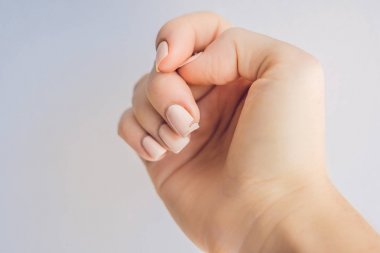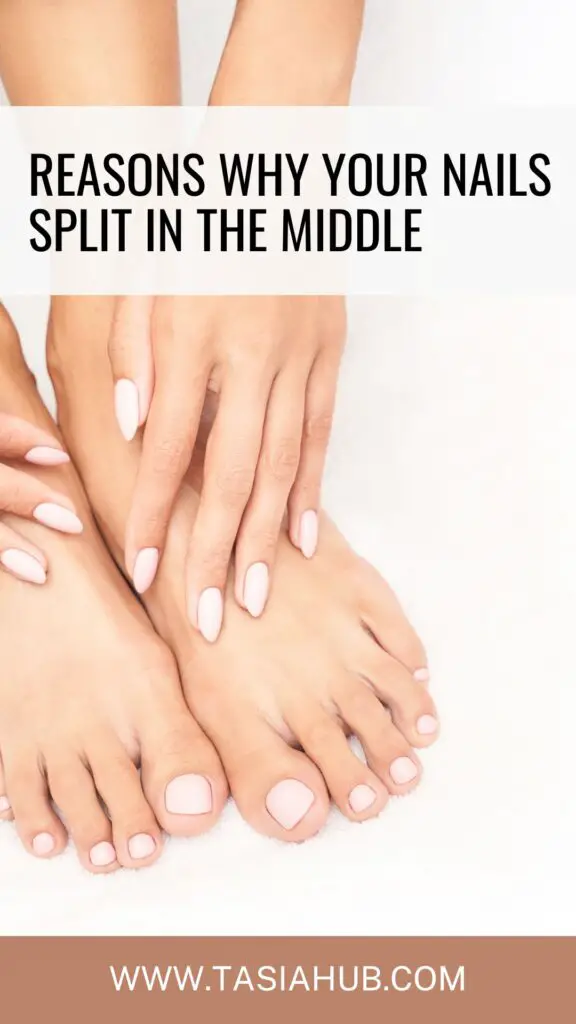Why Do My Nails Split Down The Middle?

Are you tired of dealing with split nails? You’re not alone. Many people experience the frustration of nails splitting down the middle.
But why does this happen? In this comprehensive guide, we will explore the causes, treatments, and prevention methods for split nails.
Whether you’re dealing with a traumatic injury, an underlying condition like psoriasis, or simply excessive exposure to moisture, we’ve got you covered. Let’s dive in and find out why your nails are splitting and how you can fix them.

Understanding The Causes Of Split Nails
Nail splitting, scientifically known as onychoschizia, can occur for various reasons, It’s important to identify the underlying cause to effectively address the issue. Here are some common factors that contribute to nails splitting down the middle:
Trauma Or Injury
One of the most common causes of split nails is physical trauma or injury. Accidentally catching your finger in a door, pinching it under a heavy object, or ripping it on something sharp can all lead to nail splitting. In severe cases, the injury may even affect the nail bed, causing further damage.
Biting Or Picking
If you’re in the habit of biting or picking at your nails, you may be weakening them. Anxiety often manifests as nail picking, which gradually decreases the strength of the nails and makes them more prone to splitting. Additionally, picking at a nail can directly cause it to split.
Excessive Exposure To Moisture
While staying hydrated is essential for nail health, excessive exposure to water can weaken your nails, spending prolonged periods in a pool, frequent dishwashing, or submerging your hands in bathwater can all contribute to nail splitting. Nail polish, if used frequently, can also weaken the nails, making them more susceptible to splitting.
Nail Psoriasis
Psoriasis is a skin condition characterized by red, scaly patches or plaques. Nail psoriasis affects a significant percentage of individuals with psoriasis. It weakens the nails, making them more prone to splitting, if you have psoriasis, it’s essential to manage the condition to prevent further damage to your nails.
Other Underlying Conditions
Although less common, several underlying conditions can make nails more prone to splitting. These conditions include bacterial, fungal, or yeast infections, thyroid disease, kidney disease, skin cancers, and liver disease. Identifying and addressing these conditions is crucial for maintaining healthy nails.
Treatments And Home Remedies For Split Nails
Now that we understand the causes of nail splitting, let’s explore various treatments and home remedies to fix this issue. In most cases, you can address split nails at home using simple methods.
However, severe splits or nail bed involvement may require medical treatment. Here are some effective ways to fix split nails:
Glue
One popular home remedy involves reattaching the split nail using adhesive, applying a small amount of glue to the detached nail, and gently pressing it back together. Once the glue has set, you can paint your nail to hide the split and improve its appearance.
Tea Bag
Another home remedy involves using a tea bag to reinforce the split nail. Cut a small piece of a tea bag and use adhesive to glue it in place, after the glue has set, buff the nail and apply polish if desired. The tea bag provides additional support and helps the split nail grow out.
Gel And Silk Wrap
A gel and silk wrap can effectively hold the split nail in place, cut a piece of silk wrap to match the size of the broken nail. Place the silk wrap against the nail and apply a gel coat, once the gel sets, you can buff the nail and apply polish for a finished look.
Fake Nail
If the split is severe, you can consider using a fake nail. You have the option to remove the piece that is splitting off or leave it in place. Apply a fake nail either to the broken nail alone or to all nails for a uniform appearance.
Medical Treatments
In some cases, medical treatment is necessary to address split nails. If you have an underlying condition like psoriasis or an acute infection, medication may be required to prevent further damage to your nails. Consult with a healthcare provider to determine the best course of action.
When To Seek Medical Attention
While most split nails can be managed at home, certain symptoms warrant medical attention. If you notice any of the following signs, it’s crucial to seek professional help:
- Distorted nails
- Bluish or purplish color
- Ingrown nails
- Painful nails
- White discoloration under nails
- Horizontal ridges on nails
These symptoms may indicate underlying issues that require additional medical treatment. Your healthcare provider can assess the situation and provide appropriate care.
Prevention Tips For Split Nails
Preventing split nails is key to maintaining their health and strength, while it’s not always possible to avoid nail splitting entirely, you can take precautions to minimize the risk. Here are some helpful tips:
- Maintain a healthy diet rich in vitamins and minerals. Good nutrition plays a crucial role in nail health.
- Consider taking biotin supplements with the consent of a doctor. Biotin is a B vitamin that promotes healthy nails.
- Regularly moisturize your nails and cuticles to keep them hydrated.
- Minimize excessive exposure to water. Wear gloves when doing chores or using cleaning chemicals.
- Avoid using harsh nail polish removers that can weaken the nails.
- Give your nails a break from polishes and gels occasionally to allow them to breathe.
- Refrain from pulling at hangnails, as this can cause further damage.
- Wear adequate protection and exercise caution when working with your hands to prevent trauma.
By following these preventive measures, you can significantly reduce the likelihood of experiencing split nails.
Conclusion
Dealing with split nails can be frustrating, but understanding the causes and available treatments can make a significant difference.
Whether your nails are splitting due to physical trauma, anxiety-induced picking, excessive moisture, or an underlying condition like psoriasis, there are various remedies you can try at home.
If the splits are severe or associated with other concerning symptoms, seeking medical attention is crucial. By taking preventive measures and adopting a nail-friendly lifestyle, you can minimize the occurrence of split nails. Remember to prioritize nail health and give your nails the care they deserve.
Now that you have a comprehensive understanding of why your nails split down the middle, it’s time to take action and address the issue. Say goodbye to split nails and hello to healthier, stronger nails!
